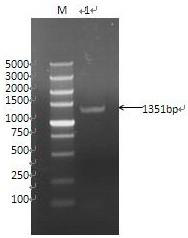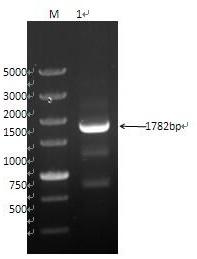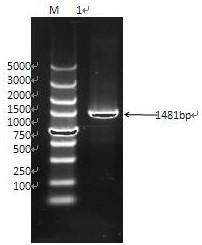Wheat TaRPP13 gene and application thereof in wheat powdery mildew resistant breeding
A powdery mildew resistance gene and wheat technology, applied in the field of agricultural biological genetic engineering, can solve problems such as unseen sequence and function research
- Summary
- Abstract
- Description
- Claims
- Application Information
AI Technical Summary
Problems solved by technology
Method used
Image
Examples
Embodiment 1
[0045] TaRPP13 Gene sequence acquisition
[0046] 1 Experimental materials
[0047] 1.1 Plant material and strains
[0048] Jing 411, a wheat variety sensitive to powdery mildew, was donated by Professor Yang Zuomin of China Agricultural University. Powdery mildew resistant wheat variety Brock, a gift from Dr Ray Johnson. Near-Isogenic Lines (NILs) of powdery mildew-resistant hybrid varieties. In the previous experiments in our laboratory, the susceptible variety Jing 411 was used as the female parent to cross with the resistant variety Brock, and the powdery mildew in the F1 generation was selected. The resistant plant is the female parent, Jing 411 is used as the male parent for 7 consecutive generations of backcrossing, and the resulting offspring are bred after one generation of self-crossing (for the preparation method, please refer to the cultivation of near-isogenic lines of wheat Brock powdery mildew resistance gene by Zhang Rong et al. and Molecular Detection, Chi...
Embodiment 2
[0097] TaRPP13 Analysis of Differential Expression of Genes in Different Resistance Wheat
[0098] 1 Experimental materials and methods
[0099] 1.1 Plant material and strain (same as Example 1)
[0100] 1.2 TaRPP13 Analysis of gene expression patterns induced by powdery mildew
[0101] Wheat Jing 411, Brock and NILs were cultivated to the second-leaf stage. The powdery mildew was evenly inoculated on the back of the leaves, and the materials were weighed and quickly frozen in liquid nitrogen at 0hr, 2hr, 4hr, 8hr, 12hr, 24hr and 48hr after inoculation. RNA from each of the three varieties at 7 time points was extracted (same as in Example 1), and oligo(dT)18 was used as a reverse transcription primer to reverse transcribe into cDNA using the M-MLV system (same as in Example 1).
[0102] according to TaRPP13 Semi-quantitative RT-PCR primers semi-RPP13-F and semi-RPP13-R were designed for non-conserved segments in the gene sequence (see Table 1). Using Tabulin as an inte...
Embodiment 3
[0113] Evaluation using the VIGS method TaRPP13 Contribution of genes to powdery mildew resistance
[0114] 1 Materials and methods
[0115] 1.1 VIGS recombinant vector construction
[0116] The barley stripe mosaic virus (BMV) used for VIGS vector construction is a positive-strand RNA virus with 3 genomes: α, β and γ. Since the viral genome RNA is not suitable for direct manipulation, the viral RNA was reverse-transcribed into cDNA for further modification. Among them, add a place at the start codon of γb of the γ chain Nhe I Restriction site for insertion of cloned DNA fragments.
[0117] 1. According to TaRPP13 Gene sequence, in the non-conserved region of the gene design added Nhe The primers RPP13-V-F and RPP13-V-R of the I recognition sequence (see Table 1 for the sequence). To contain TaRPP13 Plasmids with partial gene sequences were used as templates for PCR amplification. PCR reaction system: ExTaq 0.2μl, 10× ExTaq Buffer 2μl, dNTP Mixture 1.6μl, RPP13-V-...
PUM
 Login to View More
Login to View More Abstract
Description
Claims
Application Information
 Login to View More
Login to View More - R&D
- Intellectual Property
- Life Sciences
- Materials
- Tech Scout
- Unparalleled Data Quality
- Higher Quality Content
- 60% Fewer Hallucinations
Browse by: Latest US Patents, China's latest patents, Technical Efficacy Thesaurus, Application Domain, Technology Topic, Popular Technical Reports.
© 2025 PatSnap. All rights reserved.Legal|Privacy policy|Modern Slavery Act Transparency Statement|Sitemap|About US| Contact US: help@patsnap.com



